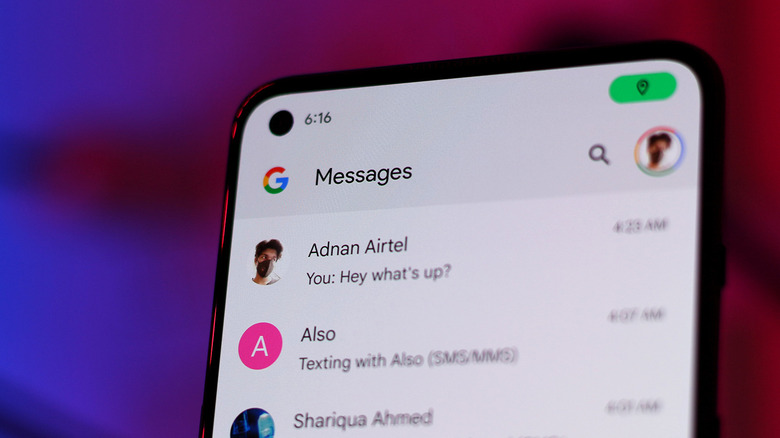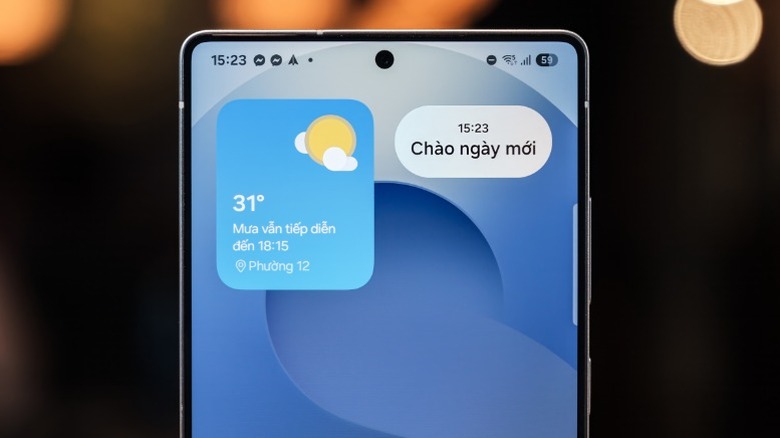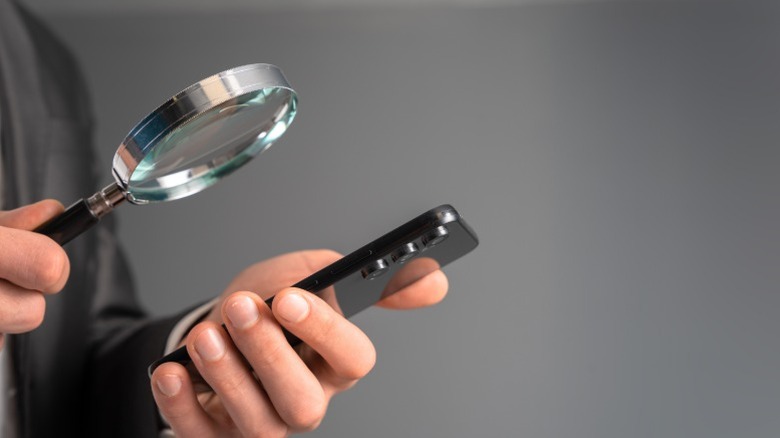Here's What That Black 'Dot' On Top Of Your Android Phone Is For
From bulky constructions capable of only making phone calls, or sending texts if you're lucky, to giant screens that connect you to the internet — the transformation of cell phones is an exciting technological feat. Both Android and iOS devices now do a lot more, with new features being showcased like clockwork every iteration. With so much happening on the screen, the various symbols and icons on your Android phone's screen can be a quick and easy way to tell which app or system notifications are waiting for you.
These indicators are often miniature versions of the app icons themselves — so if you receive a text on WhatsApp, you'll see the app's tiny icon on your status bar. Certain symbols, like the key icon on Android, indicate other features of your device, such as VPN, network, or battery status. You will also notice an occasional green dot in the status bar — this denotes active camera or microphone use by an app or service.
However, a black dot is usually not a software element of any toggle on Android. It could always be a possibility that a poorly optimized app hasn't yet crafted a unique symbol and is instead just displaying a black dot in place of a notification. This should be easy enough to confirm — just swipe down to access your notifications and clear them all. If there's still a black dot at the top — it could be one of two things.
The black dot is actually a camera
If you own an Android device from the last few years, it is highly likely that the black dot at the top of your phone's screen is actually the front-facing camera. For years, the front camera on smartphones was cloaked behind thick bezels on the display. The Essential PH-1 was one of the first popular Android smartphones to have debuted a waterdrop-style notch at the top to house the front camera. Many other devices followed suit, but often had a noticeable bezel at the bottom.
Fast forward to 2025, and most premium Android devices have nearly bezel-less displays all around with a hole punch cutout for the front-facing camera. Some smartphones position this near the center, while others align it towards the left or the right. In essence, the persistent "dot" you may have been worried about is an essential hardware feature of the phone. You can confirm this by opening up the camera app and trying to cover the black dot with your finger.
Samsung phones have the option to "hide" the camera cutout. This can be found by navigating to Settings > Display > Camera cutout. You can configure this option on a per-app basis. When turned on, the feature basically adds a black bar at the top where the hole punch or waterdrop cutout is situated. This can be a viable option if you find the camera cutout distracting while using certain apps or playing games.
Checking for possible screen damage on your phone
A-hole punch camera is easy to spot, especially if you shine some external light over it. While some flagships like the Samsung Galaxy S25 Ultra we reviewed have front-facing cameras with impressively small diameters, most budget phones make the hardware inclusion quite noticeable with bigger hole-punch setups. That said, if you notice black dots other than the front-facing camera on your phone's screen, this could indicate screen damage — especially if you've dropped your phone by accident.
A form of display damage that closely aligns with the "black dot" diagnosis could be a dead pixel. These are smaller, pixel-sized black spots on the screen that don't respond to any changes happening on the display — hence the name. Dead pixels are often caused by the malfunctioning of the transistor that's responsible for controlling it. Similarly, stuck pixels often appear as either permanent red, green, or blue spots on the display.
A damaged screen might also progressively get worse with use. You may notice pixel bleed from the edges of your phone, or ink blots that may affect any area of the screen. In such cases, your best bet is to get a screen replacement. The cost of repair will vary depending on your phone's model and whether it's currently in warranty or protected by a damage protection plan. For instance, the cost to replace a Samsung phone screen ranges from $99 to $444, depending on the model.


